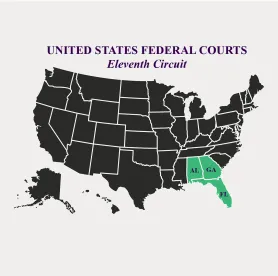On a matter of first impression, the U.S. Eleventh Circuit, in Durham v. Rural/Metro Corp., applied the test for indirect evidence of intentional pregnancy discrimination enunciated by the U.S. Supreme Court in Young v. UPS.
Background
Plaintiff began work in March 2015 as an emergency medical technician (“EMT”) for Rural/Metro Corporation (“Rural”), which provides private ambulance and fire-protection services across twenty-one (21) states. Plaintiff’s duties required her to frequently lift stretchers, which weigh more than 100 pounds, patients, and supplies. In August 2015, Plaintiff became pregnant, and, one month later, her doctor put her on lift restrictions, advising her not to lift more than 50 pounds during her pregnancy. When Plaintiff informed her general manager about these pregnancy-related restrictions, both individuals agreed that she would not be able to work on the ambulance, and Plaintiff asked for an alternative light-duty or dispatch position. Rural generally provides accommodation to disabled employees on a case-by-case basis and has a light-duty policy that allows employees with work-related injuries and illnesses to work in temporary positions. Despite these options, the general manager informed Plaintiff that no light-duty or dispatch positions were available and recommended that she take unpaid personal leave.
Plaintiff filed a charge of discrimination with the Equal Employment Opportunity Commission in November 2015, followed by a federal lawsuit alleging that Rural discriminated against her in violation of the Pregnancy Discrimination Act of 1978 (“PDA”) by failing to provide her with an accommodation in line with those given to disabled or injured employees. The district court granted Rural’s motion for summary judgment, finding that Plaintiff failed to state a prima facie case because she did not show that Rural treated her less favorably than non-pregnant workers who were similarly situated in their ability or inability to work.
Decision
The Eleventh Circuit vacated summary judgment and remanded the case to the district court for further proceedings, ruling that Plaintiff established a prima facie case of pregnancy discrimination. The Court focused its analysis on the standard enunciated by the Supreme Court’s 2015 Young v. UPS decision. Young clarified that in order to establish a prima facie case of discrimination pursuant to the PDA, in cases involving indirect evidence of disparate treatment, a plaintiff must show that (1) she is a member of the protected class; (2) she requested accommodation; (3) the employer refused her request; and (4) the employer nonetheless accommodated others “similar in their ability or inability to work.” The employer could then present its “legitimate, nondiscriminatory reasons” for denying plaintiff’s requested accommodation, and plaintiff could attempt to demonstrate that the stated reasons were “pretextual.”
The lynchpin argument of cases involving indirect evidence of pregnancy discrimination is that the employer treated the pregnant employee differently than other non-pregnant employees operating under the same work-related restrictions. Here, Plaintiff argued that her pregnancy was the only reason to infer that she was different. Plaintiff and her colleagues injured on the job were similar because Plaintiff’s temporary lifting restrictions prevented her from performing her job duties – i.e., inability to work. The Court found that for this reason, and because Rural’s employee handbook hinted that the company accommodated some employees injured off the job, the district court erred by determining that Plaintiff failed to establish a prima facie case. On the contrary, she presented a prima facie case via indirect evidence. Because the district court did not reach the question of whether Rural’s stated reasons for refusing to provide Plaintiff with a light-duty or dispatcher position were pretextual, the Court remanded the case to the district court.
Concurrence
U.S. Sixth Circuit Judge Danny J. Boggs, sitting by designation, wrote a concurring opinion, delving further into the complexities of Young’s application in the post-prima facie stage of PDA cases. He noted three major changes wrought by Young: (1) a pregnant plaintiff was no longer required to show that all coworkers injured off the job were treated differently than her in order to satisfy the comparator test (similar in their ability or inability to work); (2) Young shifted consideration of the employer’s reasons for treating pregnant workers differently than those injured on the job to the legitimate-reason and pretext inquiries and away from the prima facie stage; and (3) any inference of discrimination derived from the company’s policy choices is best evaluated in the post-prima facie stage. In sum, Judge Boggs opined that the fundamental question in cases similar to this one is whether the employer’s actions give rise to a valid inference of unlawful discrimination.
Takeaways
This is our first glance at how the Eleventh Circuit, and perhaps the Sixth Circuit to some degree due to Judge Boggs’ concurrence, will handle pregnancy discrimination suits going forward. Importantly, this decision emphasizes that an employer’s proffered reason for treating a pregnant employee differently from non-pregnant employees is a factor that should be considered only in the post-prima facie analysis.
Thus, employers handling a pregnant employee’s request for accommodation during pregnancy should keep a thorough record of the interactive process and document the reasoning behind decisions made and implemented. Employers may also consider revisiting and updating any pregnancy-related policies.




 />i
/>i

